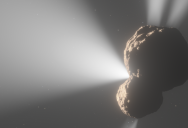Unusual Object Studied By James Webb Space Telescope Found To Be Emitting Jets Of Gas In Never Before Seen Display

The James Webb Space Telescope has recently been used to watch an interesting object known as a centaur.
Centaurs are objects that share similarities to both comets and asteroids, and until now, they were not often studied because they are usually pretty far away. This particular object has been dubbed Centaur 29P and is even more unusual because it features two jets of carbon dioxide, which are not normally present on objects like this.
The new study, which was published in the journal Nature, says that this has never been seen before and in addition to the two jets of carbon dioxide, it also has a single jet of carbon monoxide.
Geronimo Villanueva, a coauthor of the study, works at NASA’s Goddard Space Flight Center, and released a statement on this object, in which he said:
“It challenges our ideas about how primordial objects are created and stored in the Kuiper Belt.”
This centaur, and most others, are present out between the orbits of Neptune and Jupiter. They are believed to be objects that exist in the Kuiper Belt, which is a very cold area at the edge of our solar system. Sometimes, gravity from Jupiter and Neptune pull objects in from the Kuiper Belt to the inner solar system, which may be what happened in this case.

Lead author Sara Faggi of NASA commented:
“Centaurs can be considered as some of the leftovers of our planetary system’s formation. Because they are stored at very cold temperatures, they preserve information about volatiles in the early stages of the solar system. Webb really opened the door to a resolution and sensitivity that was impressive to us — when we saw the data for the first time, we were excited. We had never seen anything like this.”
Additional information is needed to learn more about this object, and especailly why it has jets of gas coming off of it.
Study coauthor Adam Mackay is an astronomer at Appalachian State University, and said in the statement:
“I’d like to go back and look at Centaur 29P over a much longer period of time. Looking at these jets over time would give us much better insights into what is driving these outbursts.”
It is not yet known if the James Webb Space Telescope will be directed at this object again to gather more information.

Space is filled with unusual things that we still don’t understand.
If you thought that was interesting, you might like to read a story that reveals Earth’s priciest precious metal isn’t gold or platinum and costs over $10,000 an ounce!

Sign up to get our BEST stories of the week straight to your inbox.




